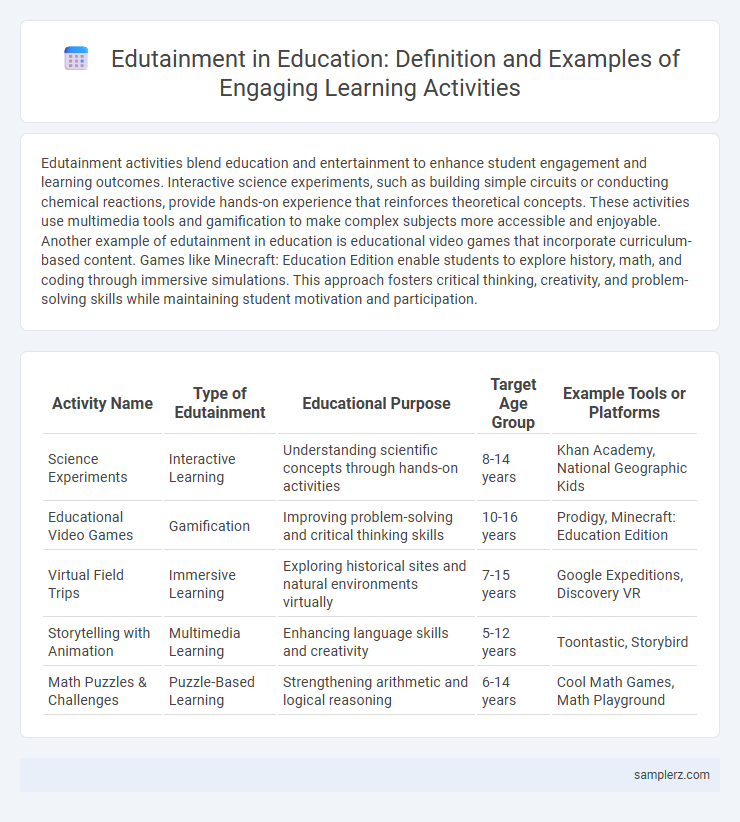Edutainment activities blend education and entertainment to enhance student engagement and learning outcomes. Interactive science experiments, such as building simple circuits or conducting chemical reactions, provide hands-on experience that reinforces theoretical concepts. These activities use multimedia tools and gamification to make complex subjects more accessible and enjoyable. Another example of edutainment in education is educational video games that incorporate curriculum-based content. Games like Minecraft: Education Edition enable students to explore history, math, and coding through immersive simulations. This approach fosters critical thinking, creativity, and problem-solving skills while maintaining student motivation and participation.
Table of Comparison
| Activity Name | Type of Edutainment | Educational Purpose | Target Age Group | Example Tools or Platforms |
|---|---|---|---|---|
| Science Experiments | Interactive Learning | Understanding scientific concepts through hands-on activities | 8-14 years | Khan Academy, National Geographic Kids |
| Educational Video Games | Gamification | Improving problem-solving and critical thinking skills | 10-16 years | Prodigy, Minecraft: Education Edition |
| Virtual Field Trips | Immersive Learning | Exploring historical sites and natural environments virtually | 7-15 years | Google Expeditions, Discovery VR |
| Storytelling with Animation | Multimedia Learning | Enhancing language skills and creativity | 5-12 years | Toontastic, Storybird |
| Math Puzzles & Challenges | Puzzle-Based Learning | Strengthening arithmetic and logical reasoning | 6-14 years | Cool Math Games, Math Playground |
Integrating Games in Classroom Learning
Integrating games in classroom learning enhances student engagement and improves comprehension by combining educational content with interactive gameplay. Popular examples include using platforms like Kahoot! for real-time quizzes and Minecraft: Education Edition to teach subjects such as history and science through immersive simulations. Research shows that game-based learning increases retention rates by up to 40%, making it an effective edutainment strategy in modern education.
Educational Storytelling for Student Engagement
Educational storytelling enhances student engagement by transforming complex concepts into memorable narratives that foster deeper understanding and retention. Integrating multimedia elements such as animations and interactive quizzes within stories captivates diverse learning styles and promotes active participation. This edutainment approach bridges enjoyment and education, making learning experiences more impactful and motivating for students.
Interactive Science Experiments as Edutainment
Interactive science experiments engage students by combining hands-on activities with educational content, enhancing comprehension of complex scientific concepts. These experiments encourage exploration, critical thinking, and problem-solving, making learning both fun and memorable. Utilizing tools such as virtual labs, simulations, and real-time data collection further amplifies the edutainment value in science education.
Virtual Reality Adventures in Education
Virtual Reality Adventures in Education transform learning by immersing students in interactive 3D environments that enhance retention and engagement. These VR experiences simulate historical events, scientific explorations, or complex engineering concepts, allowing learners to practice skills in a risk-free virtual setting. Studies show VR-based learning improves information recall by up to 75%, making it a powerful edutainment tool that bridges education and entertainment effectively.
Using Music and Songs to Teach Concepts
Using music and songs to teach concepts enhances memory retention and engagement by combining auditory learning with educational content. For example, incorporating alphabet songs helps young children memorize letters and sounds effectively, while math songs reinforce number sequences and basic arithmetic skills. This edutainment strategy leverages rhythm and melody to create an interactive and enjoyable learning environment.
Educational Field Trips with Gamified Elements
Educational field trips enhanced with gamified elements transform traditional learning by encouraging active participation through scavenger hunts, quizzes, and interactive challenges tailored to curriculum topics. These activities boost student engagement and retention by combining experiential learning with game mechanics such as point scoring, leaderboards, and instant feedback. Implementing technology like mobile apps or AR devices during excursions further enriches the educational experience by providing real-time contextual information and personalized learning paths.
Role-Playing Activities for History Lessons
Role-playing activities in history lessons immerse students by reenacting historical events and characters, enhancing engagement and comprehension. This edutainment approach fosters critical thinking and empathy through experiential learning, making complex historical concepts memorable. Incorporating authentic costumes, scripts, and scenarios deepens understanding of cultural and societal contexts, reinforcing curriculum objectives effectively.
Animated Videos for Complex Subject Explainers
Animated videos simplify complex subjects by using engaging visuals and storytelling techniques to enhance understanding and retention. These videos combine education and entertainment, breaking down difficult concepts like scientific processes or historical events into easily digestible, memorable segments. Schools and online platforms increasingly adopt animated explainers to boost student engagement and improve learning outcomes in subjects such as biology, physics, and social studies.
Augmented Reality Apps in Language Learning
Augmented reality (AR) apps in language learning, such as Mondly AR and AR Learn, create immersive environments where students can interact with virtual objects and characters to practice vocabulary and grammar in real-time. These AR tools enhance retention by providing contextual and visual cues that make language acquisition more engaging and intuitive. Integrating AR technology in classrooms promotes active participation and accelerates speaking and comprehension skills through realistic simulations.
Board Games that Reinforce Academic Skills
Board games such as Scrabble and Math Bingo effectively reinforce academic skills by combining fun with learning, promoting vocabulary building and arithmetic practice. These interactive games engage students in strategic thinking, problem-solving, and collaboration, fostering deeper understanding of core subjects. Incorporating board games into education enhances motivation and retention through hands-on, experiential learning.

example of edutainment in activity Infographic
 samplerz.com
samplerz.com